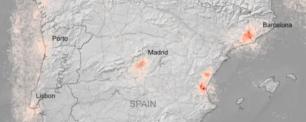COVID-NOX
Global decoupling of COVID-19 infection and activities from lockdown to post-lockdown period using observations from the space
Non-pharmaceutical measures such as population confinement are essential to contain the spread of the coronavirus disease 2019 (Covid-19), but they have a negative effect on the economy by reducing industrial and commercial activities.
However, the effect of the percentage reduction in activity to contain the pandemic has not been examined. In this project we will use the daily emissions estimated from statistical data on energy consumption in different countries and satellite data for nitrogen dioxide (NO2) measured by the Ozone Monitoring Instrument (OMI) as an indicator of the reduction of activities due to the confinement and non-pharmaceutical measures. We will analyze the relationship between the reduction of daily CO2 emission activities and the decrease in the rate of new cases of Covid-19 using both statistical data of energy consumption and satellite data of the atmospheric column of NO2.
In a preliminary analysis, we found that early actions were effective in China, while a delay of one week would have required greater containment with twice the emissions reduction to achieve the same goal and thus more economic damage. We will conduct a socio-economic analysis to analyze the value of public health benefits as a result of reduced activities compared to the loss of gross domestic product. Our analyzes will shed light on the cost of maintaining CO2-emitting activities during the epidemic and the socio-economic benefits of containment.
Our goal is to find a successful response strategy characterized by identifying countries and territories that managed to reduce infection rates in the short term, showing a relatively strong correlation between activity data and infections, but in a follow-up phase. managed to resume activities. without increasing infections. Our study will shed light on the debate on "health-economics", which assumes that both are independent of each other and, therefore, there is a choice between the two. Our data will be useful to guide confinment policies if the prevalence of Covid-19 increases again or when a new virus emerges globally in the future. Our geographic method will be able to monitor the effectiveness of containment using global satellite data in any region where epidemiological data is available. Our qualitative results will inform where confinement and non-pharmaceutical measures are effective to contain the epidemic and how the virus can be effectively contained. Our results will be useful to inform when it is appropriate to raise control over the incidence of the virus and the probability of infection. If we can finally say that the measures significantly influence infections, but do not need to undermine the reversal of activity, that would be a great success.














